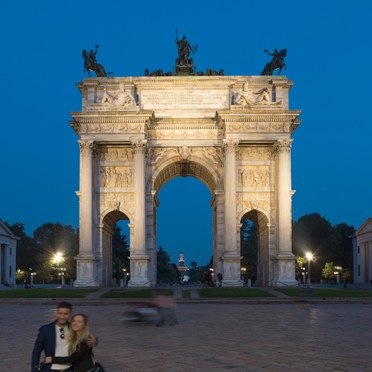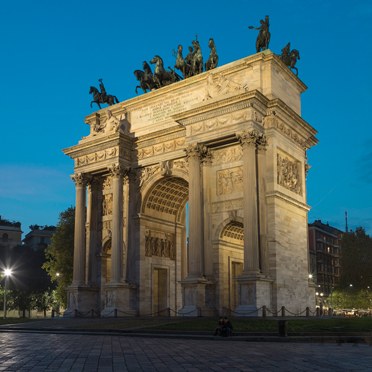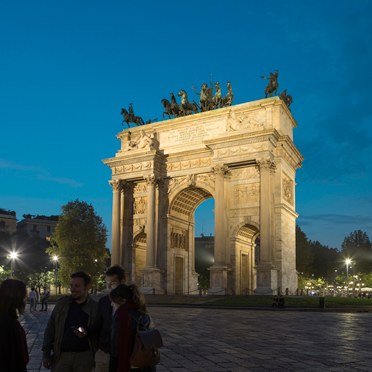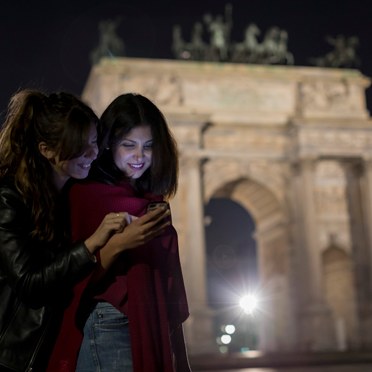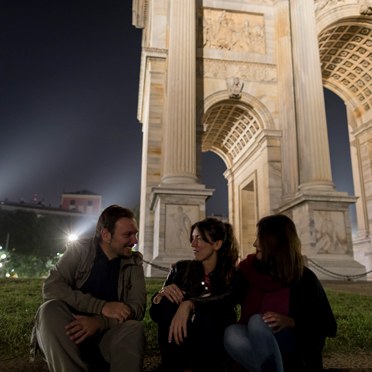Thorn puts the famous Arco della Pace in a tasteful new light
- Lamp efficacy
Lamp efficacy
Ensuring the lamp efficiently converts electricity into light (lm/W).
- Ballast classification
Ballast classification
Controlling the electricity supply to the lamp (Energy Efficiency Index).
- Luminaire distribution
Luminaire distribution
Controlling light emission using optics which bend and shape the light to the correct location.
- System efficacy
System efficacy
Combining optical and thermal control within the luminaire (luminaire lm/W).
- Presence/absence detection
Presence/absence detection
Presence: Lights automatically turn on/off with movement. Absence: Lights automatically turn off and must be manually switched on.
- Daylight detection
Daylight detection
Artificial lighting which responds to the natural light conditions.
- Constant illuminance
Constant illuminance
A function designed to produce correct light levels for the duration of the maintenance period.
- Task-scene setting
Task-scene setting
Allowing the user to set scenes and adapt the lighting to different tasks.
- Timed off
Timed off
Automatic cut-off can be installed to turn all lights off during unoccupied hours.
- Task lighting
Task lighting
Lighting task areas with the correct amount of light.
- Zoning of lighting
Zoning of lighting
Lighting is zoned according to area use.
- Maintenance schedule
Maintenance schedule
Maintenance must be performed in response to product age, performance and environment.
- Waste light
Waste light
Eliminating waste light which does not hit the intended target.
- Reflectance
Reflectance
Taking advantage of light which is reflected from the surface within the space.
- Visible smart metering
Visible smart metering
Results of actions can be quickly seen as increased or decreased energy use to encourage responsible energy consumption.
LED luminaires from Thorn are now illuminating the Arco della Pace, one of the most important neoclassical monuments in Milan. A series of Contrast 2 LED floodlights has been installed around the imposing “Arch of Peace” to pick out the intricate details and fine workmanship, improving the overall visitor experience and simultaneously saving resources by boosting efficiency.
Finding the right angle
Mounted on the 20 existing posts surrounding the arch, the compact architectural LED floodlights have been equipped with an additional optical filter to focus the light perfectly onto the architecture. The adoption of a primary optic with a beam angle of only 8° guarantees concentrated light, while the optic filter placed on top creates a thin rectangular distribution that complements the shape of the arch. Thanks to a filter holder that can be rotated, the light from every Contrast 2 LED fitting installed around the arch is projected parallel to the monument at all times.
Balancing architecture and safety
The Arco della Pace brings together the past and the present in Milan. The granite construction with a marble finish symbolises the rich history and architectural heritage of the Lombardy regional capital, while at the same time representing an important focal point and meeting place for both residents and tourists. This means that the site has to balance aesthetic considerations with issues of comfort and security – especially for the many people who visit the arch at night.
The Milanese authorities therefore looked for a new lighting solution that could deliver clean, precise and efficient illumination for both the monument and the surrounding area. The new installation needed to tastefully highlight the various architectural shapes and decorative elements, enhance the perception of the urban space and increase the feeling of safety for the public.
About Arco della Pace
Work on the Arco della Pace, designed by Luigi Cagnola in honour of Napoleon Bonaparte, was first started in 1807 and then promptly put on hold after the defeat of the French leader at Waterloo. The arch was finally finished in 1838 by Francis I of Austria and dedicated to the peace established between the European nations that attended the Congress of Vienna in 1815. The monument is topped by a six-horsed bronze Sestiga della Pace (Chariot of Peace) sculpted by Abbondio Sangiorgio and also features representations of the four rivers of the Lombardy-Veneto region (the Po, the Ticino, the Adige and the Tagliamento) in the form of reclining statues created by Benedetto Cacciatori and Pompeo Marchesi.

